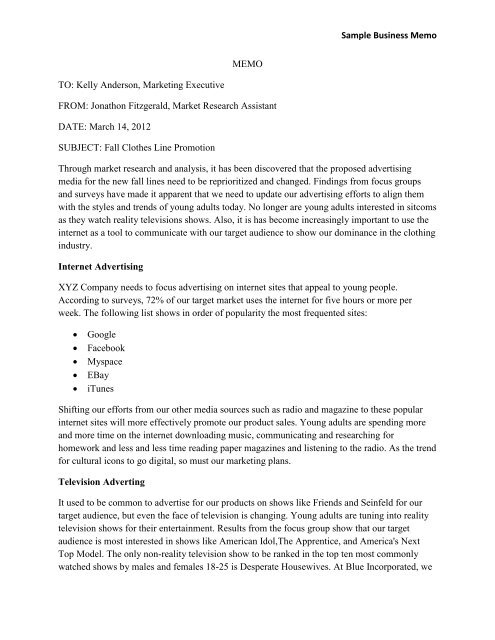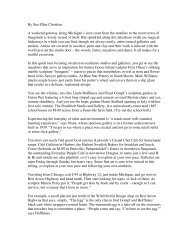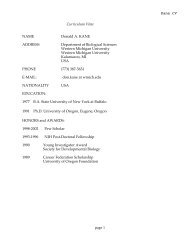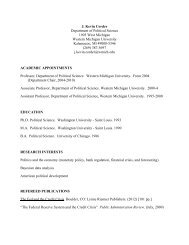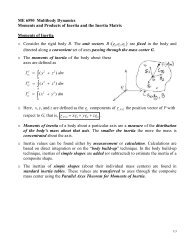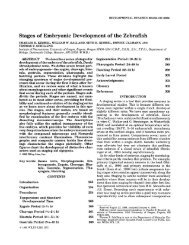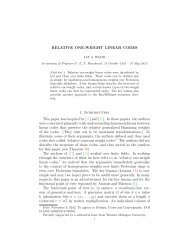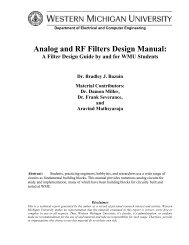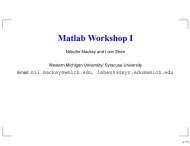Sample Business Memo MEMO TO: Kelly Anderson, Marketing ...
Sample Business Memo MEMO TO: Kelly Anderson, Marketing ...
Sample Business Memo MEMO TO: Kelly Anderson, Marketing ...
You also want an ePaper? Increase the reach of your titles
YUMPU automatically turns print PDFs into web optimized ePapers that Google loves.
<strong>TO</strong>: <strong>Kelly</strong> <strong>Anderson</strong>, <strong>Marketing</strong> Executive<br />
<strong>MEMO</strong><br />
FROM: Jonathon Fitzgerald, Market Research Assistant<br />
DATE: March 14, 2012<br />
SUBJECT: Fall Clothes Line Promotion<br />
<strong>Sample</strong> <strong>Business</strong> <strong>Memo</strong><br />
Through market research and analysis, it has been discovered that the proposed advertising<br />
media for the new fall lines need to be reprioritized and changed. Findings from focus groups<br />
and surveys have made it apparent that we need to update our advertising efforts to align them<br />
with the styles and trends of young adults today. No longer are young adults interested in sitcoms<br />
as they watch reality televisions shows. Also, it is has become increasingly important to use the<br />
internet as a tool to communicate with our target audience to show our dominance in the clothing<br />
industry.<br />
Internet Advertising<br />
XYZ Company needs to focus advertising on internet sites that appeal to young people.<br />
According to surveys, 72% of our target market uses the internet for five hours or more per<br />
week. The following list shows in order of popularity the most frequented sites:<br />
Google<br />
Facebook<br />
Myspace<br />
EBay<br />
iTunes<br />
Shifting our efforts from our other media sources such as radio and magazine to these popular<br />
internet sites will more effectively promote our product sales. Young adults are spending more<br />
and more time on the internet downloading music, communicating and researching for<br />
homework and less and less time reading paper magazines and listening to the radio. As the trend<br />
for cultural icons to go digital, so must our marketing plans.<br />
Television Adverting<br />
It used to be common to advertise for our products on shows like Friends and Seinfeld for our<br />
target audience, but even the face of television is changing. Young adults are tuning into reality<br />
television shows for their entertainment. Results from the focus group show that our target<br />
audience is most interested in shows like American Idol,The Apprentice, and America's Next<br />
Top Model. The only non-reality television show to be ranked in the top ten most commonly<br />
watched shows by males and females 18-25 is Desperate Housewives. At Blue Incorporated, we
need to focus our advertising budget on reality television shows and reduce the amount of<br />
advertising spent on other programs.<br />
By refocusing our advertising efforts of our new line of clothing we will be able to maximize the<br />
exposure of our product to our target market and therefore increase our sales. Tapping into the<br />
trends of young adults will help us gain market share and sales through effective advertising.<br />
Attachments: Focus Group Results, January- May 2011; Survey Findings, January - April 2011<br />
This is a sample memo; facts and statistics used are fictional.<br />
http://owl.english.purdue.edu/owl/resource/590/02/
Parts of a <strong>Memo</strong><br />
Standard memos are divided into segments to organize the information and to help achieve the<br />
writer's purpose.<br />
Heading Segment<br />
The heading segment follows this general format:<br />
<strong>TO</strong>: (readers' names and job titles)<br />
FROM: (your name and job title)<br />
DATE: (complete and current date)<br />
SUBJECT: (what the memo is about, highlighted in some way)<br />
Make sure you address the reader by his or her correct name and job title. You might call the<br />
company president "Maxi" on the golf course or in an informal note, but "Rita Maxwell,<br />
President" would be more appropriate for a formal memo. Be specific and concise in your<br />
subject line. For example, "Clothes" as a subject line could mean anything from a dress code<br />
update to a production issue. Instead use something like, "Fall Clothes Line Promotion."<br />
Opening Segment<br />
The purpose of a memo is usually found in the opening paragraph and includes: the purpose of<br />
the memo, the context and problem, and the specific assignment or task. Before indulging the<br />
reader with details and the context, give the reader a brief overview of what the memo will be<br />
about. Choosing how specific your introduction will be depends on your memo plan style. The<br />
more direct the memo plan, the more explicit the introduction should be. Including the purpose<br />
of the memo will help clarify the reason the audience should read this document. The<br />
introduction should be brief, and should be approximately the length of a short paragraph.<br />
This is a sample memo; facts and statistics used are fictional.<br />
http://owl.english.purdue.edu/owl/resource/590/02/
Context<br />
The context is the event, circumstance, or background of the problem you are solving. You may<br />
use a paragraph or a few sentences to establish the background and state the problem. Oftentimes<br />
it is sufficient to use the opening of a sentence to completely explain the context, such as,<br />
"Through market research and analysis..."<br />
Include only what your reader needs, but be sure it is clear.<br />
Task Segment<br />
One essential portion of a memo is the task statement where you should describe what you are<br />
doing to help solve the problem. If the action was requested, your task may be indicated by a<br />
sentence opening like,<br />
"You asked that I look at...."<br />
If you want to explain your intentions, you might say,<br />
"To determine the best method of promoting the new fall line, I will...."<br />
Include only as much information as is needed by the decision-makers in the context, but be<br />
convincing that a real problem exists. Do no ramble on with insignificant details. If you are<br />
having trouble putting the task into words, consider whether you have clarified the situation. You<br />
may need to do more planning before you're ready to write your memo. Make sure your purposestatement<br />
forecast divides your subject into the most important topics that the decision-maker<br />
needs.<br />
Summary Segment<br />
If your memo is longer than a page, you may want to include a separate summary segment.<br />
However, this section not necessary for short memos and should not take up a significant amount<br />
of space. This segment provides a brief statement of the key recommendations you have reached.<br />
These will help your reader understand the key points of the memo immediately. This segment<br />
may also include references to methods and sources you have used in your research.<br />
This is a sample memo; facts and statistics used are fictional.<br />
http://owl.english.purdue.edu/owl/resource/590/02/
Discussion Segments<br />
The discussion segments are the longest portions of the memo, and are the parts in which you<br />
include all the details that support your ideas. Begin with the information that is most important.<br />
This may mean that you will start with key findings or recommendations. Start with your most<br />
general information and move to your specific or supporting facts. (Be sure to use the same<br />
format when including details: strongest to weakest.) The discussion segments include the<br />
supporting ideas, facts, and research that back up your argument in the memo. Include strong<br />
points and evidence to persuade the reader to follow your recommended actions. If this section is<br />
inadequate, the memo will not be as effective as it could be.<br />
Closing Segment<br />
After the reader has absorbed all of your information, you want to close with a courteous ending<br />
that states what action you want your reader to take. Make sure you consider how the reader will<br />
benefit from the desired actions and how you can make those actions easier. For example, you<br />
might say,<br />
"I will be glad to discuss this recommendation with you during our Tuesday trip to the spa and<br />
follow through on any decisions you make."<br />
Necessary Attachments<br />
Make sure you document your findings or provide detailed information whenever necessary.<br />
You can do this by attaching lists, graphs, tables, etc. at the end of your memo. Be sure to refer<br />
to your attachments in your memo and add a notation about what is attached below your closing,<br />
like this:<br />
Attached: Focus Group Results, January- May 2007<br />
This is a sample memo; facts and statistics used are fictional.<br />
http://owl.english.purdue.edu/owl/resource/590/02/


